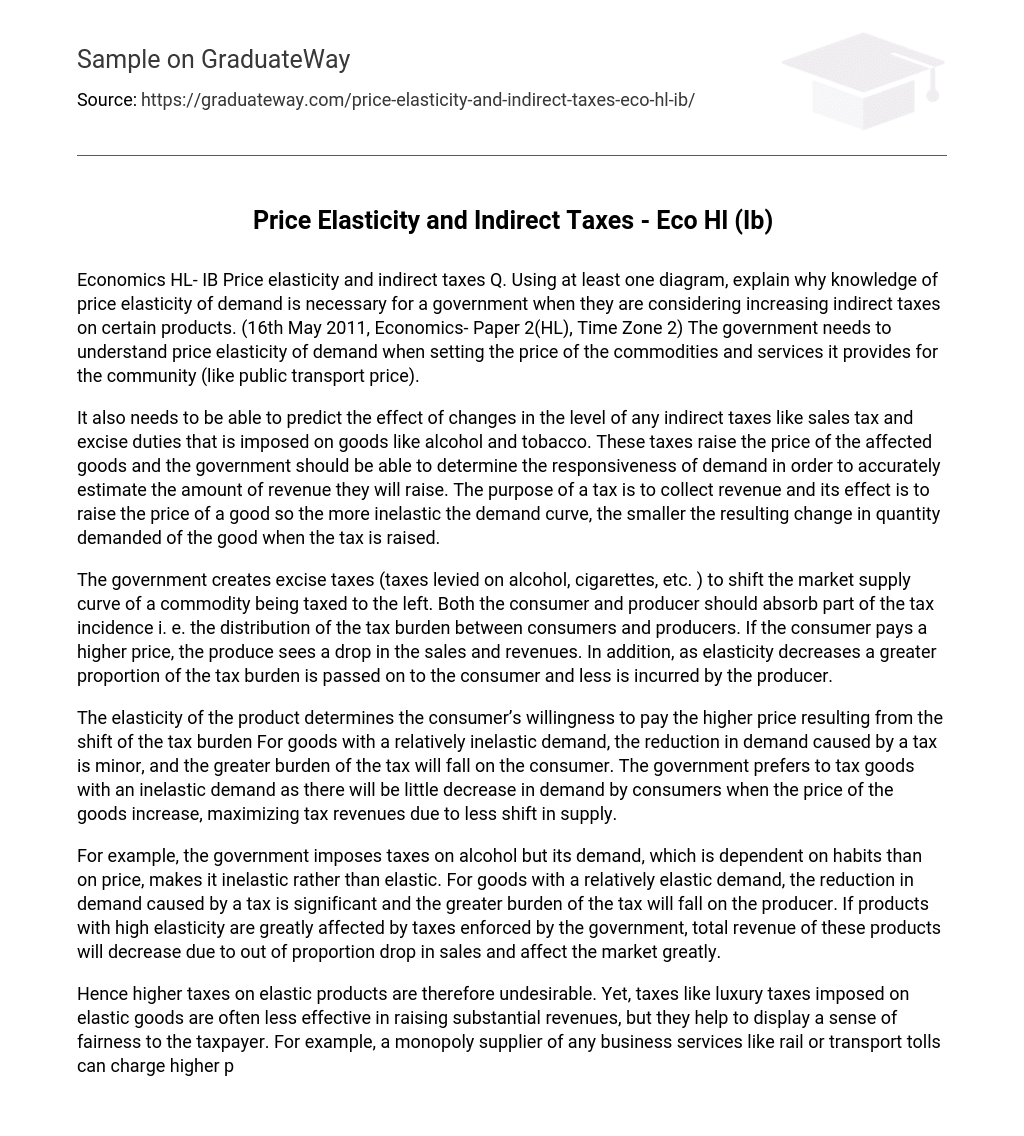Economics HL- IB Price elasticity and indirect taxes Q. Using at least one diagram, explain why knowledge of price elasticity of demand is necessary for a government when they are considering increasing indirect taxes on certain products. (16th May 2011, Economics- Paper 2(HL), Time Zone 2) The government needs to understand price elasticity of demand when setting the price of the commodities and services it provides for the community (like public transport price).
It also needs to be able to predict the effect of changes in the level of any indirect taxes like sales tax and excise duties that is imposed on goods like alcohol and tobacco. These taxes raise the price of the affected goods and the government should be able to determine the responsiveness of demand in order to accurately estimate the amount of revenue they will raise. The purpose of a tax is to collect revenue and its effect is to raise the price of a good so the more inelastic the demand curve, the smaller the resulting change in quantity demanded of the good when the tax is raised.
The government creates excise taxes (taxes levied on alcohol, cigarettes, etc. ) to shift the market supply curve of a commodity being taxed to the left. Both the consumer and producer should absorb part of the tax incidence i. e. the distribution of the tax burden between consumers and producers. If the consumer pays a higher price, the produce sees a drop in the sales and revenues. In addition, as elasticity decreases a greater proportion of the tax burden is passed on to the consumer and less is incurred by the producer.
The elasticity of the product determines the consumer’s willingness to pay the higher price resulting from the shift of the tax burden For goods with a relatively inelastic demand, the reduction in demand caused by a tax is minor, and the greater burden of the tax will fall on the consumer. The government prefers to tax goods with an inelastic demand as there will be little decrease in demand by consumers when the price of the goods increase, maximizing tax revenues due to less shift in supply.
For example, the government imposes taxes on alcohol but its demand, which is dependent on habits than on price, makes it inelastic rather than elastic. For goods with a relatively elastic demand, the reduction in demand caused by a tax is significant and the greater burden of the tax will fall on the producer. If products with high elasticity are greatly affected by taxes enforced by the government, total revenue of these products will decrease due to out of proportion drop in sales and affect the market greatly.
Hence higher taxes on elastic products are therefore undesirable. Yet, taxes like luxury taxes imposed on elastic goods are often less effective in raising substantial revenues, but they help to display a sense of fairness to the taxpayer. For example, a monopoly supplier of any business services like rail or transport tolls can charge higher prices in peak periods and low prices in off-peak periods because the price elasticity of demand is inelastic in peak periods compared to off-peak periods.
This means that they can use the price discrimination strategy to maximize revenue. Conclusion If demand is price elastic, decreasing the price benefits the producer as: * Fall in price causes a rise in total revenue * Rise in price causes a fall in total revenue If demand is price inelastic, then increasing the price benefits the producers more: * Rise in price causes a rise in total revenue * Fall in price causes a fall in total revenue
Hence the government should put taxes on consumers when the demand is inelastic compared to the supply while the tax should be put on the producers when the supply is more inelastic to maximize total revenue and cause as less economic loss to consumers and producers in the form of deadweight loss. Sources: * welkerswikinomics. wetpaint. com * www. socyberty. com * www. tutor2u. net * www. acceleratedstudynotes. com * www. nointrigue. com * http://spot. colorado. edu/~kaplan/econ2010/section4/section4-main. html





